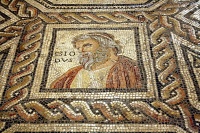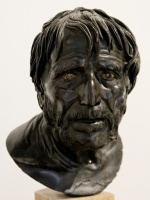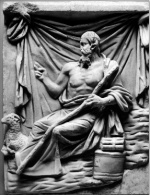Hesiod: A Guide to Ancient Representations: Difference between revisions
| Line 36: | Line 36: | ||
Pausanias mentions three portraits of Hesiod. {{#lemma: One was part of the fifth-century “Micythus dedication” at Olympia | [[Homer: A Guide to Selected Sources]] [[Pausanias, Description of Greece 5.26.2 | Paus. 5.26.2]]}} made by the Argive sculptors Glaucus and Dionysius. The second describes a sculpture at the Grove of the Muses, on Helicon. {{#lemma: Pausanias considers the portrait to depict Hesiod incorrectly, as he is seated and playing a lyre despite inferences from Hesiod’s own works that suggested he stood with a staff and sang without a lyre (West 1966: 164; Clay 2004: 56) | [[Hesiod: A Guide to Selected Sources]] [[Pausanias, Description of Greece 9.30.2 | Paus. 9.30.2]]}}. {{#lemma: Pausanias also mentions a bronze portrait of Hesiod in the market-place at Thespiae | [[Pausanias, Description of Greece 9.27.5 | Paus. 9.27.5]]}}. | Pausanias mentions three portraits of Hesiod. {{#lemma: One was part of the fifth-century “Micythus dedication” at Olympia | [[Homer: A Guide to Selected Sources]] [[Pausanias, Description of Greece 5.26.2 | Paus. 5.26.2]]}} made by the Argive sculptors Glaucus and Dionysius. The second describes a sculpture at the Grove of the Muses, on Helicon. {{#lemma: Pausanias considers the portrait to depict Hesiod incorrectly, as he is seated and playing a lyre despite inferences from Hesiod’s own works that suggested he stood with a staff and sang without a lyre (West 1966: 164; Clay 2004: 56) | [[Hesiod: A Guide to Selected Sources]] [[Pausanias, Description of Greece 9.30.2 | Paus. 9.30.2]]}}. {{#lemma: Pausanias also mentions a bronze portrait of Hesiod in the market-place at Thespiae | [[Pausanias, Description of Greece 9.27.5 | Paus. 9.27.5]]}}. | ||
{{#lemma: The ''Ekphrasis'' of Christodorus | [[Christodorus of Thebes, | {{#lemma: The ''Ekphrasis'' of Christodorus | [[Christodorus of Thebes, Ekphrasis 38-40|Christodorus ''Ek.'' 38-40]]}}, a late fifth-century CE poem that describes the sculptural decoration of the Gymnasium of Zeuxippus at Constantinople, describes a bronze portrait of Hesiod, and the terms of his description (χαλκὸν δὲ βιάζετο, ‘and he strained against the bronze’) suggest that Hesiod’s portrait depicted him vividly and dramatically. It is tempting to relate this description to the palpably ‘straining’ image of Hesiod in the “Pseudo-Seneca Type”, but any such connection remains hypothetical. | ||
== Bibliography == | == Bibliography == | ||
Revision as of 21:03, 14 September 2015
Correlate the sources mentioned in the guide to those listed in the margin using the mouse.
William Wallis
There is only one securely identified representation of Hesiod from the ancient world (the Monnus-Mosaic in the Rheinisches Landesmuseum, Trier), and there are two sculptural types for which an identification of Hesiod has been postulated (the Pseudo-Seneca Type, and the Naples-Type Hesiod). There are several accounts of portraits of Hesiod in ancient sources.
The Monnus-Mosaic Hesiod 
A bearded male, wearing a fillet and dressed in a buff tunic and rufous mantle, is depicted in three-quarter profile from the mid-torso up (Richter 1965: 57; Schefold 1997: 390-1). He appears elderly and dignified, and his head tilts slightly to the right, as if listening or in thought. The figure is identified by name: ‘ESIO-DVS’ is written to its left. The portrait of Hesiod has little to distinguish it from generic portraits of bearded Greek males and bears no specific resemblance to any surviving named or unnamed portrait (though Schefold recognises a similarity to the Apollonius of Tyana Type Homer Homer: A Guide to Sculptural Types, Schefold 1997: 390-1).
This figure is part of a late third-century CE mosaic from a square room, with sides measuring 5.70m and an adjoining apse on the North-West wall. The room is part of a building discovered in 1884 during the building of the Rheinisches Landesmuseum in Trier (Goethert and Goethert-Polaschek 1979; Dahm 1979; Hoffmann 1999: 39-46). The earliest Roman building remains on the site date from the first century CE, but it was largely remodelled in the late third or early fourth century (at which time the Monnus-Mosaic was added). Much of the building is heated by hypocaust (under-floor hot air circulation), and the layout of the building suggests that this was a domestic building. The proposal that the building might have been a public library has been dismissed as speculation (Goethert and Goethert-Polaschek 1979).
The mosaic is signed in its central field by the maker, ‘MONNUS FECIT’ (‘Monnus made this’). Although severely fragmentary, partial reconstruction is possible: a central octagon was surrounded by eight further octagons (providing nine in total); each displayed one of the nine Muses paired with an ancient practitioner of each Muse’s art. The surviving octagons feature Homer, Hyagnis, Epicharmus, Thamyris, Cadmus, and Aratus (Daniel 1996). All these figures have at times been considered prōtoi heurētai (first inventors) of their particular specialisms. Among and between these octagons are twenty small squares, in each of which was depicted a literary figure, a theatre mask, or a personified month. Of the literary figures in these small squares, Hesiod, Menander, Ennius, Virgil, Diodorus, Cicero, and Livy survive in various states of fragmentation. The complete effect of the room would presumably have been a canon of literary prōtoi heurētai paired with their relevant Muses, and surrounded by the principal exponents of each literary form.
Given its highly literary mosaic decoration, we can speculate that the room was used for occasions on which the display of high-cultural credentials was important. The mosaic features both Greek and Latin writers, philosophers and historians, and this suggests that the mosaic’s commissioner (though his origin and role are unknown) wished to associate himself with a broad classical education. Hesiod’s inclusion indicates that, for the third-century mosaicist Monnus and his employer in Trier, Hesiod was part of a canon by which an elite could signal partnership in Greco-Roman cultural heritage, despite the several hundred miles that separate Trier from Rome itself.
The Pseudo-Seneca Type 
Far better known than the Monnus-Mosaic Hesiod is an unidentified portrait type known as the Pseudo-Seneca Type (Strandman 1950; Richter 1965: 58-63; Schefold 1997: 266-9; Mattusch and Lie 2005: 249-253). Between thirty-eight and forty examples of this portrait type survive, with a further ten lost or doubtful examples. Despite some variation, particularly in the degree of fineness and details of the locks of hair, the majority of these heads have enough in common to be an unmistakably recognisable type. The majority show little more than head and neck, though some show parts of the shoulders and some of the chest. A male figure is shown who is often described as conspicuously aged, although in fact he appears to be in late middle-age with the haggard appearance of one who has lived a life of hard labour. Loose skin hangs beneath his chin, and gathers about his neck. His brow is marked with curving horizontal furrows. His cheeks have collapsed, and are sunken (to various degrees in the different examples). His hair radiates in relatively few long, thick locks, three of which dramatically intrude onto the poet’s brow. His beard and moustache appear thin, tufted and matted. These characteristics have been considered by Zanker as those of a peasant (1995: 150-54). Stylistically this portrait compares to other examples of Hellenistic ‘realism’, such as the Old Fisherman, Drunken Old Woman and Old Beggar Woman. Most scholars date this portrait’s archetype to the second century BCE.
The identification of this portrait has long been controversial. It appears as Seneca in publications of the late-sixteenth century, on the basis of similarity to a coin once seen by the collector Fulvio Orsini (Galle 1598: 131; Faber 1606: 74). Orsini’s numismatic expertise was considerable, but many of his identifications are untenable. Identification as Seneca led to the adoption of this portrait type by Neo-Stoic philosophers of the sixteenth and seventeenth centuries. It is prominently located on a wall-niche in Rubens’ painting The Four Philosophers (Pitti Palace, Florence; Morford 1991), above the posthumous portrait of Justus Lipsius. The similarity of this head in style to that of the Louvre Old Fisherman led to the Old Fisherman also being identified as Seneca, and placed in a marble basin to evoke Seneca’s bathtub suicide. Rubens also integrated elements of this head and the Louvre Old Fisherman in the Death of Seneca (Munich, Alte Pinakothek; McGrath 1997: II.282-97).
More recent scholars dismiss the identification as Seneca on the basis that not only are several examples of the portrait contemporary or near contemporary with Seneca’s own life (and such a dramatic portrait seems unlikely for a recently dead Stoic scholar) but also because of an inscribed portrait of Seneca discovered in 1813 that is wholly different in appearance (Antikensammlung, Staatliche Museen, Berlin, Sk 391; Schefold 1997: 376-7).
The identification that has gained most (though far from universal) support is that the portrait represents Hesiod. Proponents of this theory point out that one example (Museo Nazionale delle Terme inv. 612) wears an ivy wreath, suggesting that it depicts a poet, and that two examples are found in back-to-back double-portraits with other poets: one with Menander (Villa Albani, Casino, no. 67), and one with an unidentified clean-shaven head, possibly Virgil (Ny Carlsberg Glyptothek, IN 611; Richter 1965: 58; Zanker 1995: 150-54). This makes it most likely that the portrait depicts a famous Greek poet. The number of extant examples seems to suggest that this poet was among the most famous. Hesiod’s poetry dwells on the hardship of the life of mortals. This bleak outlook has been thought to fit the distraught appearance of the portrait more appropriately than that of any other poet. Moreover the head’s matted and untidy coiffure have been considered (by some) as part of the iconography of peasanthood, and Hesiod’s role as a teacher of farming would fit this role well (Zanker 1995: 150-4).
Many different identifications have been made, including Ennius and even Aristophanes (Strandman 1950; von Heintze 1983; Schefold 1997: 166-9). However, the Hesiod identification, though doubtful, remains the most convincing suggestion. The methodological problems of basing identifications on our own expectations and receptions of ancient poets has been pointed out effectively by modern scholars, and most are resigned to leaving the portrait type unidentified.
The Naples-Type Hesiod 
One further speculative identification has gained a following. A sarcophagus in Naples shows an old, balding, bearded man in a rural setting; he holds a staff, and is accompanied by a sheep and a capsa (cylindrical scroll-case). This combination of old man, sheep, staff, and papyrus scrolls has led to a convincing suggestion that the poet represented is Hesiod, who presents his young self as a shepherd at the opening of the Theogony Hesiod: A Guide to Selected Sources Hes. Theog. 22-34 (Haubold 2010). A bust in the Capitoline Museum bears a striking resemblance to that on the sarcophagus, in its bald crown, hair around the back and sides of the head, and long, flowing beard (Musei Capitolini inv. 523 = Stanza dei Filosofi no. 14). The figure’s body appears moderately firm and muscular in both cases and both the bust and the sarcophagus show a similar arrangement of drapery over the left shoulder. The figure’s face in the Capitoline bust appears stern and accusatory. Vertical furrows between the eyebrows combine with horizontal wrinkles across the forehead to evoke a severe man. The bust has conspicuously large ears, which lend it an appearance of age and dignity (Lauer-Picard 1955: 96-108; Richter 1965: 57; Schefold 1997: 262-3)
Literary accounts of portraits of Hesiod
Pausanias mentions three portraits of Hesiod. One was part of the fifth-century “Micythus dedication” at Olympia Homer: A Guide to Selected Sources Paus. 5.26.2 made by the Argive sculptors Glaucus and Dionysius. The second describes a sculpture at the Grove of the Muses, on Helicon. Pausanias considers the portrait to depict Hesiod incorrectly, as he is seated and playing a lyre despite inferences from Hesiod’s own works that suggested he stood with a staff and sang without a lyre (West 1966: 164; Clay 2004: 56) Hesiod: A Guide to Selected Sources Paus. 9.30.2. Pausanias also mentions a bronze portrait of Hesiod in the market-place at Thespiae Paus. 9.27.5.
The Ekphrasis of Christodorus Christodorus Ek. 38-40, a late fifth-century CE poem that describes the sculptural decoration of the Gymnasium of Zeuxippus at Constantinople, describes a bronze portrait of Hesiod, and the terms of his description (χαλκὸν δὲ βιάζετο, ‘and he strained against the bronze’) suggest that Hesiod’s portrait depicted him vividly and dramatically. It is tempting to relate this description to the palpably ‘straining’ image of Hesiod in the “Pseudo-Seneca Type”, but any such connection remains hypothetical.
Bibliography
- Clay, D. 2004. Archilochos Heros: The Cult of Poets in the Greek Polis. Cambridge, MA.
- Dahm, L. 1979. ‘Die neuen Rekonstruktion der im Bereich des Landesmuseums Trier gefigürlichen römischen Mosaiken.’ In Festschrift: 100 Jahre Rheinisches Landesmuseum Trier: Beiträge zur Archäologie und Kunst des Trierer Landes. Trier: 97-110.
- Daniel, R. W. 1996. ‘Epicharmus in Trier: A Note on the Monnus-Mosaic.’ ZPE 114: 30-36.
- Goethert, K.-P. and Goethert-Polaschek, K. 1979. ‘Das Gebäude mit dem Monnus-Mosaik: Die Ausgrabungen unter dem Rheinischen Landesmuseum Trier von 1884-1962.’ In Festschrift: 100 Jahre Rheinisches Landesmuseum Trier: Beiträge zur Archäologie und Kunst des Trierer Landes. Trier: 69-96.
- Haubold, J. H. 2010. ‘Shepherd, farmer, poet, sophist: Hesiod on his own reception.’ In J. H. Haubold and G. R. Boys-Stones (eds.), Plato and Hesiod. Oxford: 11-30.
- von Heinze, H. 1983. ‘Pseudo-Seneca: Esiodo o Ennio?’ In D. Mustilli and M. Gigante (eds.), La Villa dei Papiri. Naples: 19-30.
- Hoffmann, P. 1999. Römische Mosaike im Rheinischen Landesmuseum Trier: Führer zur Dauerausstellung. Trier.
- Lauer, J. P. and Picard, C. 1955. Les Statues Ptolémaïques du Sarapieion de Memphis. Paris.
- Mattusch, C. C., and Lie, H. 2005. The Villa dei Papiri at Herculaneum: Life and Afterlife of a Sculpture Collection. Los Angeles.
- McGrath, E. 1997. Rubens: Subjects from History. London.
- Morford, M. P. O. 1991. Stoics and Neostoics: Rubens and the Circle of Lipsius. Princeton, NJ.
- Richter, G. M. A. 1965. The Portraits of the Greeks. London.
- Schefold, K. 1997. Die Bildnisse der antiken Dichter, Redner und Denker. Basel.
- Strandman, B. 1950. ‘The Pseudo-Seneca Problem.’ Konsthistorisk Tidskrift 19: 53-93.
- West, M. L. 1966. Hesiod: Theogony. Oxford.
- Zanker, P. 1995. The Mask of Socrates: The Image of the Intellectual in Antiquity. Berkeley.
